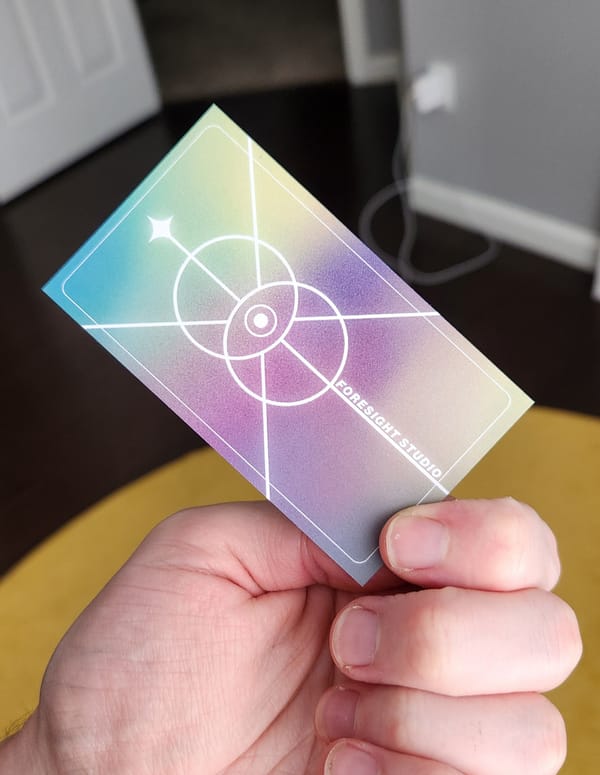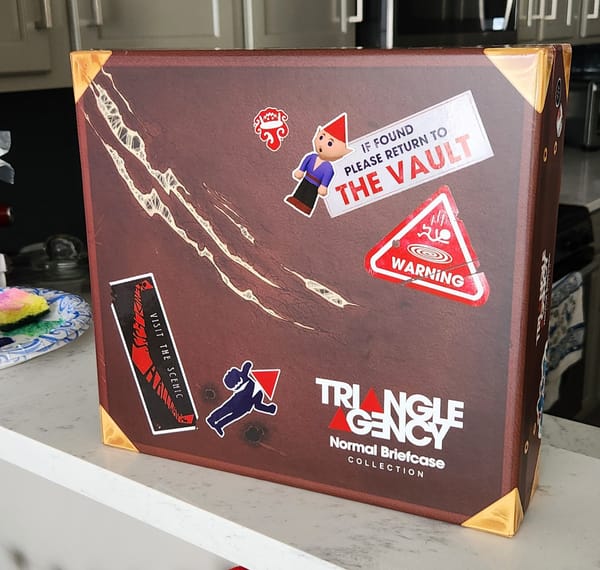Composition & Decomposition
A free game about life after death, and a peek at my design process
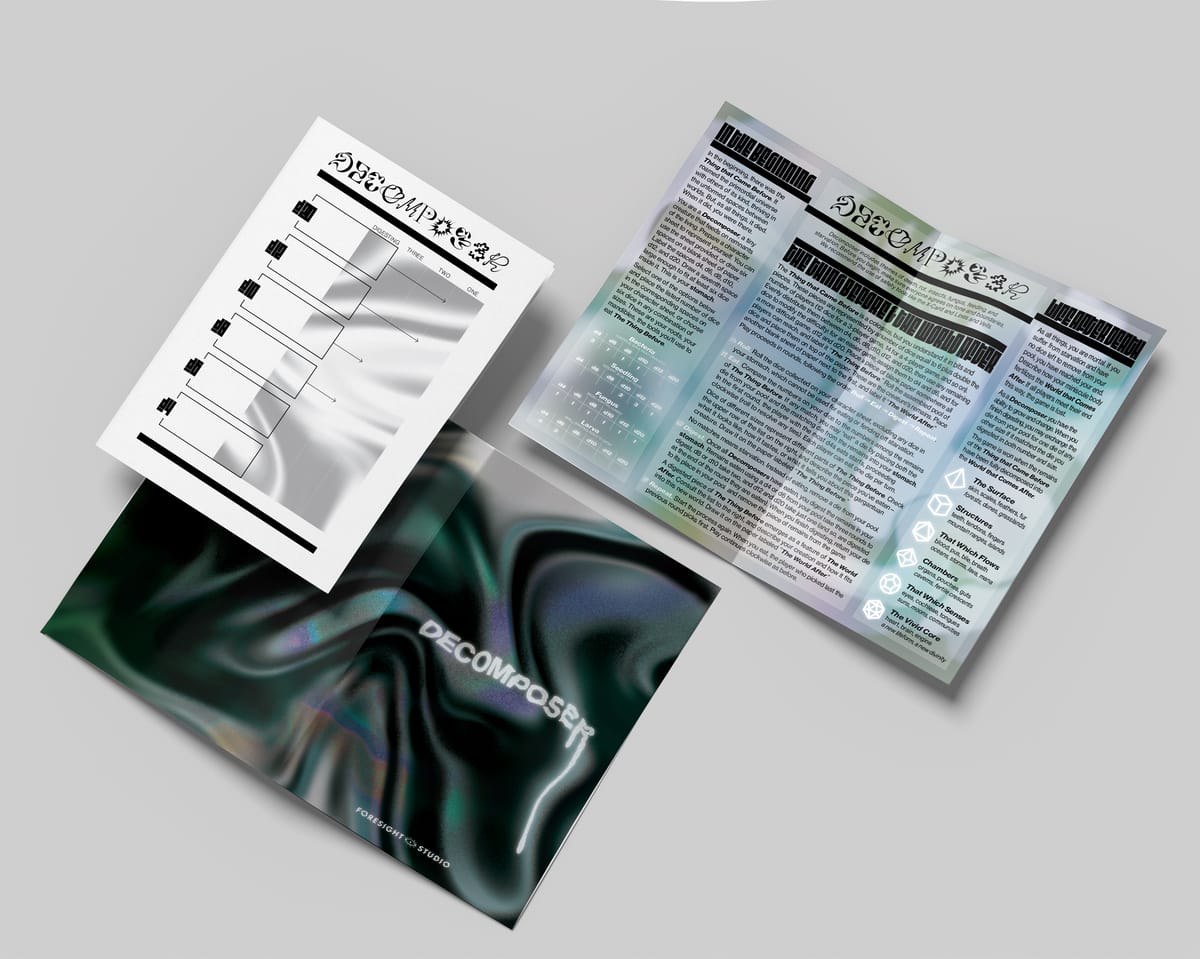
In this month’s newsletter, I’ll tell you a little bit about my design process using the character sheet for my upcoming game Hillbrook Glen: Follow your Bliss as an example. But before we cover composition, I want to talk decomposition. This week, I published a (free) one-page RPG called Decomposer!

Decomposer is a game about life after death for 1-6 players, and it can be completed in a couple of hours. Take on the role of a tiny critter—a worm, a seed, a fungal spore—and digest the remains of a dead god. In the process, you’ll discover what sort of creature this great beast was in life, and you’ll transform its body into an entirely new world. It draws inspiration from Norse & Mesopotamian creation myths, games like The Quiet Year, and what I imagine it must be like to actually be a decomposer, feeding on the remnants of a creature so big, so complex as to be totally incomprehensible. It’s also kind of a love letter to the humble organisms that make our ecosystems function.
What else is new at the studio?
- Because of a significant influx of work at my day job, I'll be officially postponing Ex Nihilo Ad Nihilum for a bit longer. If you want more Borg-y stuff, you can still find copies of The Cross Stitch at Exalted Funeral and Indie Press Revolution (and, if you're lucky, at your friendly local game store)!
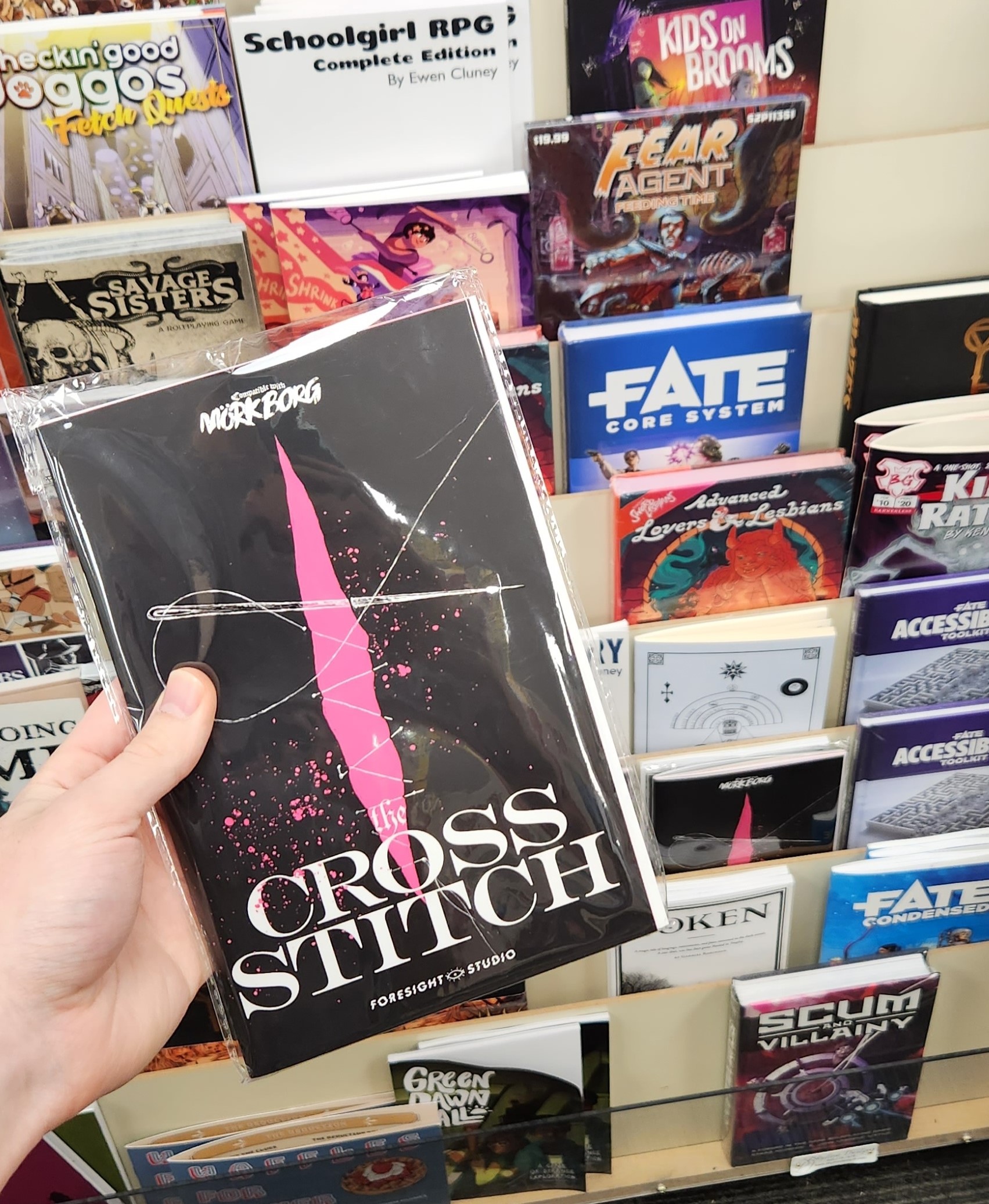
- Layout is nearing completion on The Silt Verses RPG, and I'm so excited for it to escape its confines and emerge into the world. The team has brought some really deep, fascinating mechanical twists to the Carved from Brindlewood system, and it’s such a good fit for the world of the podcast.
- I’m now also on Tumblr! It seems pretty cool so far.
Thanks for reading Tomorrow//Today! Subscribe for free to receive new posts and support my work.
Creation = Iteration
Character sheets are an interesting case. At their core, they need to be functional. But they don’t just record information, they also organize it for the player—the character sheet is what players will look at the most during play, far more than the rulebook. So, the information it contains needs to be useful, intuitive, but also flavorful.1 Like the layout of the rulebook, the character sheet is an opportunity to welcome the table into the world of the game. Plus, my favorite character sheets also stand as a kind of keepsake of my play experience, even once the character’s story is done.
Today, I'll quickly take you through three iterations of the character sheet I’m working on for Hillbrook Glen: Follow your Bliss. This is not to say these designs are final; I plan to overhaul pretty much all of this once all four planned installments of Hillbrook Glen are finished. But hopefully you’ll still find a look at the process helpful.
First, though, let me introduce Follow your Bliss in a bit more detail than I have in the past.
Follow your Bliss is a post-it crawl through the shifting meditation garden of Hillbrook Glen, a luxury wellness retreat in the Adirondack Mountains. It’s also a character study of Hillbrook Glen’s guests, who are not prepared for what they will experience there. Hillbrook Glen is alive, and it's hungry. It’s been dormant for centuries, passively feeding on the dreams and aspirations of its visitors. But the Guides who run the Glen have noticed it stirring. They want to catalyze a guest into the Glen’s avatar, one worthy to wake it from its slumber.
Of course, they do this through a series of wellness workshops. The first was Hillbrook Glen: Manifest your Dreams, and Follow your Bliss is the second. Here’s the design precedent established in Manifest your Dreams.

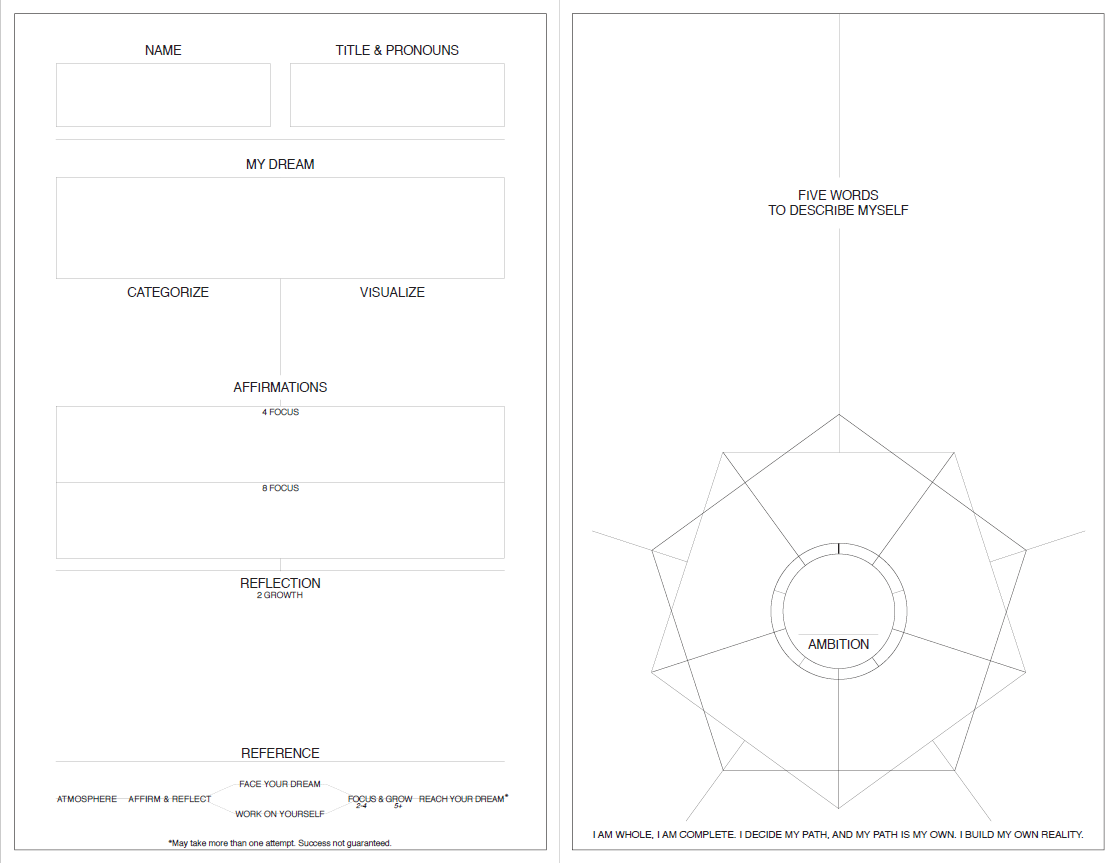
As guests explore the meditation garden during the course of Follow your Bliss, they will discover themselves slipping deeper into what functions as a kind of digestive system. Like stomach acid thins out the sturdy eggshell of a parasite so it may hatch in the intestine, the Glen scrapes away the layers of ego that prevent the guests from accessing their power. It does so by revisiting identity-defining decisions the guests made in their past, and inviting them to make a different (better?) choice. If the guests stray too far from themselves, though, they may end up devoured.
Here's where we started.
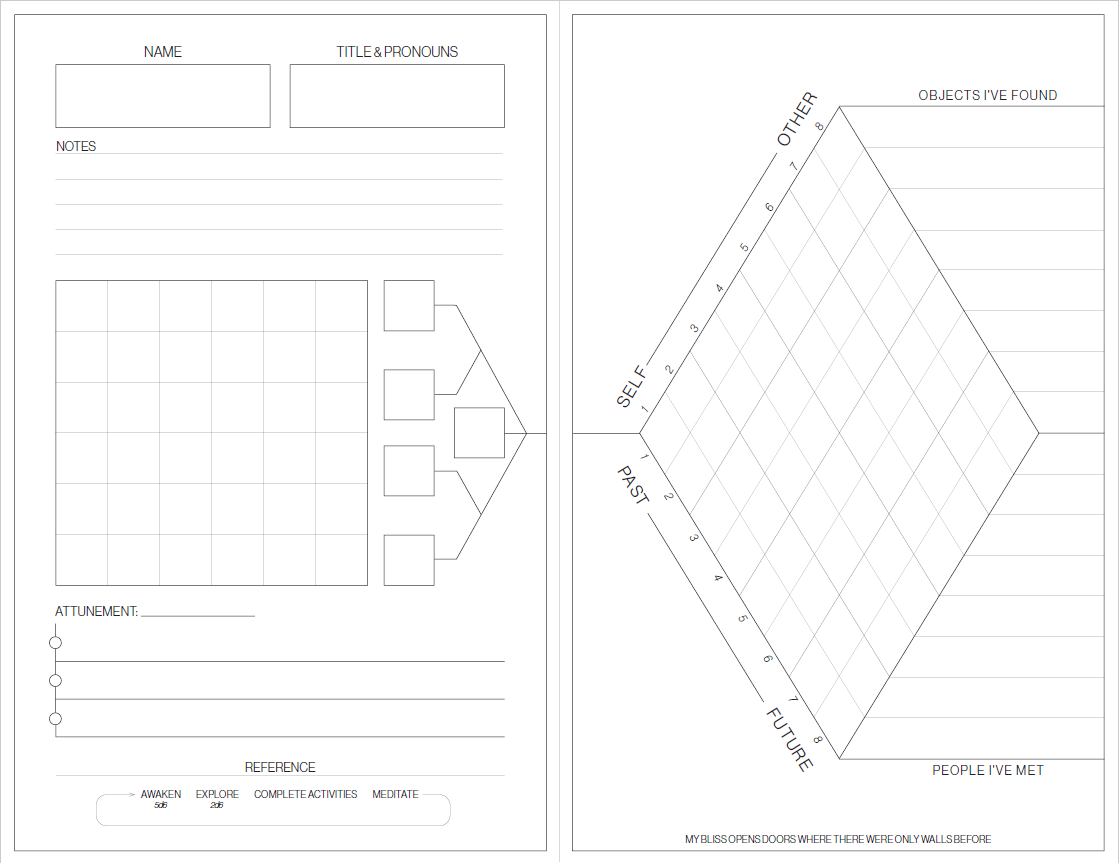
The good parts:
- The essentials are still there. It’s minimalist, on a grid, has some diagrams and a little rules reference.
- Follow your Bliss is played with a pool of 5 six-sided dice, and it’s fairly clear from the 5 square boxes where those are meant to go.
- Through play, players can track two stats, “Self-Other” and “Past-Future,” using one single diagram. And it makes cool zig-zagging lines once you’ve finished.
The not so good parts:
- The grid on the left page does not have a specified use. Using it as a map doesn’t make sense, because the map is on the table in front of you during play, and it’s also subject to change.
- The dice pool are on a tree that makes it look like there’s a hierarchy involved, like one die is special. It isn’t.
- The diagram on the right is confusing. It’s not clear how to track your stats on these axes, and where you are on the grid doesn’t actually correspond to where your character is located on the physical map.
- There is a core mechanic in this game where you slip into the aforementioned “digestive system” of the Glen, presented as the rooms of a familiar house. That was both underutilized in play, and totally missing from the character sheet.
- There’s a bunch of spaces to take different kinds of notes on items, NPCs, and miscellaneous stuff, which barely got used during play.
Here’s version 2.
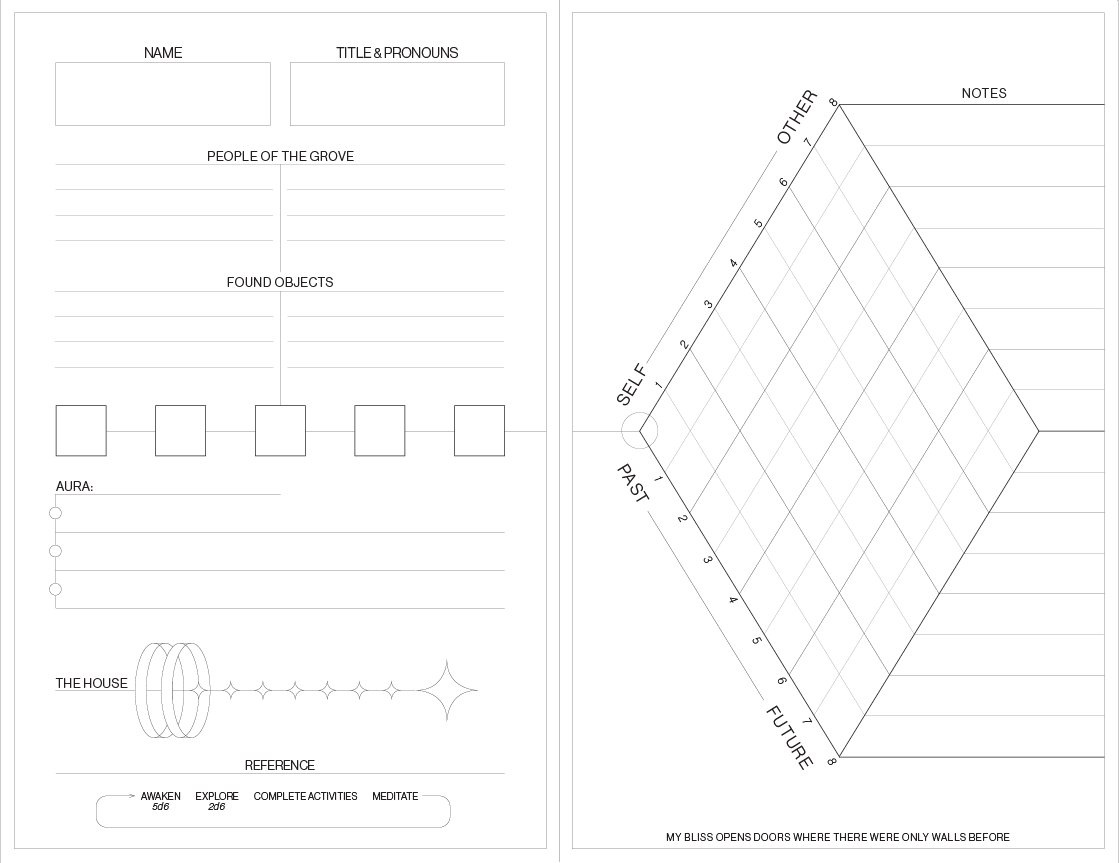
The good parts:
- It’s a bit simpler and more straightforward. Items and NPCs have a more central place on the sheet, and there’s no more unnecessary grid.
- The dice pool hierarchy is (mostly) gone.
- The House now has a place on the character sheet, along with a cool-looking little diagram of its own.
- At least in this version of the grid on the right, the numbers are on the axes rather than in the center of each box. This made tracking things a little bit easier.
The not so good parts:
- The grid on the right page remains confusing. I was holding out hope that, with some other adjustments, it would work. But, more playtesting convinced me that it—along with a couple of other underused elements—had to go.
And so, I landed on the current version.

Here, a lot has changed:
- Your pool of 5 six-sided dice has distinct places to track unspent (body) and spent (soul) dice. I’ll probably switch which squares are solid vs. open.
- You cannot “collect” NPCs, so instead, you simply have spaces to note if you pick up an item, and what size of die it will add to your pool.
- “Aura” effects were complicated and unnecessary. So, they’re gone.
- The diagram on the right consists of just one axis, balancing the the tension of self and other. You can tell that the -5 and +5 will probably get subtracted from or added to a roll.
- The grid has been replaced with a branching decision tree, which highlights the core concept (and is much less likely to get confused with a physical map). It still maintains visual callbacks to the initial design.
- On a purely composition note, I left more white space in this version, but decided to pull the name/title/pronoun boxes and the lines for items all the way to the border, which I think highlights the elements that don’t extend to the edge even more. I wanted to maintain the balance between left and right pages, so the final “star” in The House parallels the name/title/pronouns boxes, and the self/other axis aligns with the spent dice.
Overall, you can see each iteration of the character sheet drawing the game closer to its stated intent. I know there’s still tweaks to make, but hopefully seeing the character sheet evolve alongside the rules through playtesting gives you a little insight into the design process, and maybe you can take something useful from it yourself.
As a player, are there character sheets you’ve used that especially stand out? In a good way, or a bad way? If you’re a designer, what does the character sheet design process look like for you?
Regardless, I hope this prompted you to think a bit more about how information is presented and stored in TTRPGs, and how it can work with or against the stated intent of a game.
Looking to the future,
Ben // Foresight Studio
As always, would love to hear what you think about character sheets, design, or whatever, really. Find me on tumblr or twitter or mastodon, or come chat on the Foresight Studio discord server.
At some point I think a breakdown of some of my favorite character sheet designs is in order, but that will be on the docket for a future newsletter. ↩


